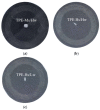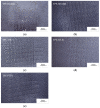Mechanism and Influence Factors of Abrasion Resistance of High-Flow Grade SEBS/PP Blended Thermoplastic Elastomer
- PMID: 35566968
- PMCID: PMC9102880
- DOI: 10.3390/polym14091795
Mechanism and Influence Factors of Abrasion Resistance of High-Flow Grade SEBS/PP Blended Thermoplastic Elastomer
Abstract
Hydrogenated styrene-butadiene-styrene block copolymer (SEBS)/polypropylene (PP) blended thermoplastic elastomer (TPE) is suitable for preparing the automotive interiors because of its excellent elasticity, softness, weather resistance, low odor, low VOC and other environmental-friendly properties. The skin of the automobile instrument panel is an appearance part, which requires excellent friction loss resistance of surface. In this paper, the high-flow SEBS/PP blended thermoplastic elastomer (TPE) suitable for the preparation of injection molding skins for automobile instrument panel was studied. By comparing the Taber abrasion and cross-scratch properties, the effects of SEBS's molecular weight, styrene content in the molecule, molecular structure and types of lubricating agents on the friction loss properties of the material were investigated. The results show that under the same SEBS molecular structure, the higher the molecular weight within a certain range, the better the wear resistance of high-flow SEBS/PP type TPE, but the ultra-high molecular weight exhibits lower wear resistance than high molecular weight; The high-flow SEBS/PP blended TPE prepared by medium styrene content SEBS has better abrasion resistance; TPE prepared by star SEBS is better than linear SEBS; Adding silane-based lubricating agents is beneficial to improve the friction loss resistance of the material, especially combined use of high and low molecular weight silicone.
Keywords: abrasion resistance; automotive interior; high-flow thermoplastic elastomer; hydrogenated styrene-butadiene-styrene block copolymer; injection molding soft skin.
Conflict of interest statement
The authors declare no conflict of interest.
Figures















Similar articles
-
Effect of SEBS Molecular Structure and Formula Composition on the Performance of SEBS/PP TPE for Automotive Interior Skin.Polymers (Basel). 2023 Jun 20;15(12):2753. doi: 10.3390/polym15122753. Polymers (Basel). 2023. PMID: 37376398 Free PMC article.
-
The Cellular Structure and Toughness of Hydrogenated Styrene-Butadiene Block Copolymer Reinforced Polypropylene Foams.Polymers (Basel). 2023 Mar 17;15(6):1503. doi: 10.3390/polym15061503. Polymers (Basel). 2023. PMID: 36987283 Free PMC article.
-
Thermoplastic Vulcanizates with an Integration of High Wear-Resistant and Anti-Slip Properties Based on Styrene Ethylene Propylene Styrene Block Copolymer/Styrene Ethylene Butylene Styrene Block Copolymer/Solution-Polymerization Styrene-Butadiene Rubber.Polymers (Basel). 2024 Aug 4;16(15):2221. doi: 10.3390/polym16152221. Polymers (Basel). 2024. PMID: 39125247 Free PMC article.
-
Effect of Acetylated SEBS/PP for Potential HVDC Cable Insulation.Materials (Basel). 2021 Mar 25;14(7):1596. doi: 10.3390/ma14071596. Materials (Basel). 2021. PMID: 33805877 Free PMC article.
-
Waste Rubber Recycling: A Review on the Evolution and Properties of Thermoplastic Elastomers.Materials (Basel). 2020 Feb 8;13(3):782. doi: 10.3390/ma13030782. Materials (Basel). 2020. PMID: 32046356 Free PMC article. Review.
Cited by
-
Biodegradable poly(ethylene glycol-glycerol-itaconate-sebacate) copolyester elastomer with significantly reinforced mechanical properties by in-situ construction of bacterial cellulose interpenetrating network.Sci Rep. 2024 Mar 26;14(1):7172. doi: 10.1038/s41598-024-56534-z. Sci Rep. 2024. PMID: 38531891 Free PMC article.
-
Advancements and Perspectives in Biodegradable Polyester Elastomers: Toward Sustainable and High-Performance Materials.Int J Mol Sci. 2025 Jan 16;26(2):727. doi: 10.3390/ijms26020727. Int J Mol Sci. 2025. PMID: 39859438 Free PMC article. Review.
-
Effect of SEBS Molecular Structure and Formula Composition on the Performance of SEBS/PP TPE for Automotive Interior Skin.Polymers (Basel). 2023 Jun 20;15(12):2753. doi: 10.3390/polym15122753. Polymers (Basel). 2023. PMID: 37376398 Free PMC article.
References
-
- Yang C.J., Yang T.C., Chen P.T., Huang K.D. An Innovative Design of Regional Air Conditioning to Increase Automobile Cabin Energy Efficiency. Energies. 2019;12:2352. doi: 10.3390/en12122352. - DOI
-
- Soutis C. Carbon fiber reinforced plastics in aircraft construction. Mater. Sci. Eng. A. 2005;412:171–176. doi: 10.1016/j.msea.2005.08.064. - DOI
-
- Kristanto D., Leephakpreeda T. Sensitivity analysis of energy conversion for effective energy consumption, thermal comfort, and air quality within car cabin. Energy Procedia. 2017;138:552–557. doi: 10.1016/j.egypro.2017.10.158. - DOI
-
- Franco-Urquiza E.A., Alcántara Llanas P.I., Rentería-Rodríguez V., Saleme R.S., Ramírez Aguilar R., Zarate Pérez C., Torres-Arellano M., Piedra S. Innovation in Aircraft Cabin Interior Panels. Part II: Technical Assessment on Replacing Glass Fiber with Thermoplastic Polymers and Panels Fabricated Using Vacuum Forming Process. Polymers. 2021;13:3258. doi: 10.3390/polym13193258. - DOI - PMC - PubMed
-
- Tejasvi R., Sharma M., Upadhyay K. Passive photo-catalytic destruction of air-borne VOCs in high traffic areas using TiO2-coated flexible PVC sheet. Chem. Eng. J. 2015;262:875–881. doi: 10.1016/j.cej.2014.10.040. - DOI
LinkOut - more resources
Full Text Sources
Miscellaneous

